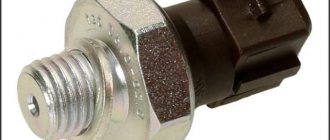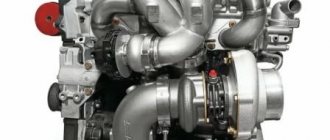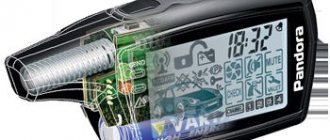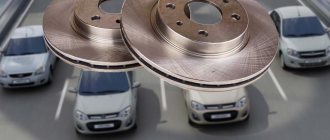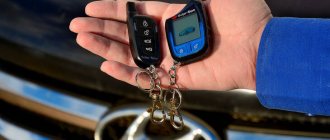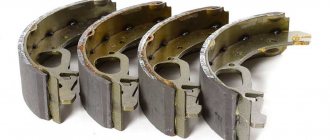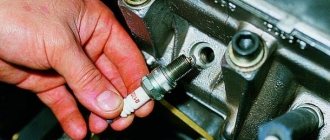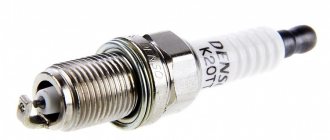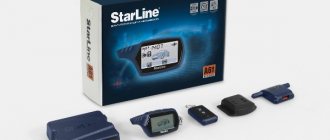ABS, or a car's anti-lock braking system, is used to prevent the wheels from locking during emergency braking. It includes an electronic control unit, a hydraulic unit and rotation sensors for the rear and front wheels. The main task of the system is to maintain vehicle controllability, ensure stability and reduce braking distance. Therefore, it is very important to maintain the good condition of all its elements. You can check the ABS sensor yourself; to do this, you need to know what type of sensor is installed on the car, signs indicating its breakdown and methods of checking. Let's look at everything in order.
More about the operating principle
Motorists have differing opinions. Some believe that ABS is designed to shorten braking distances, others believe that this is not all of its functions. Let's figure it out. When braking a car with completely locked wheels, the vehicle, due to its high mass and speed, continues to move by inertia. For example, the driver needs to brake and make a sharp maneuver away from an obstacle on the road. He has two tasks: not to lose “control” over his vehicle and reduce speed. Without the ABS system, the wheel speed will drop to zero, which means that control will be reduced to nothing - the vehicle will slide forward by inertia. But if there is such a system, the rotation of the wheels will be intermittent, but controllability will remain. Of course, from the outside it will look like some kind of chaotic movement, because with anti-locking the wheels will either lock or turn. However, the result is important: the car continues to obey the steering wheel even in extreme situations.
Today, almost all city cars are equipped with an anti-lock braking system. This is one of the safety requirements. In addition, it well complements the already complex, but extremely effective electronic “stuffing” of the vehicle.
Checking the ABS system
If the touch sensor malfunctions, it stops sending commands to the system, and the ABS does not fulfill its task, that is, the wheels are blocked when braking. If you have such a problem, you should immediately contact a car service center.
The sensors of the simplest equipment are an ordinary induction coil interacting with a toothed metal disk. The most common cause of ABS failure is a broken cable. This type of fault is diagnosed using a tester, repair pins and a soldering iron. The pins are connected to the connectors, and the resistance of the ABC sensor is measured using the tester.
This indicator should not exceed the values specified in the operating instructions. If the resistance approaches infinity, this means that a break has occurred in the electrical circuit. If it tends to zero, then we are talking about a short circuit.
If breaks are identified during a visual examination, they need to be repaired urgently. To connect them, you need to use soldering, since ordinary twisting can lead to worsening damage.
Many modern cars have a special automatic diagnostic system installed. If there is any problem, the electronics issues one or another repair code, which is deciphered using the vehicle manual.
How does it work
We have already said above that cars are actively equipped with electronics. Its heart and brain is the control unit. It is he who processes the information coming from the wheel speed sensors. In accordance with this, it issues commands to the components of the brake system, in particular to the magnetic valves. Working in this way, it not only monitors the situation on the road, but also helps the driver avoid accidents by improving controllability. This system is constantly being modernized. For example, many cars today are equipped with special sensors that react to the movement of objects on the road and “anticipate” a possible collision.
As for ABS in general, the modern system is four-channel. Each wheel is equipped with a separate sensor and is responsible for further adjustment of rotation. There is also a three-channel system: a sensor for each of the front wheels, and one sensor for a pair of rear wheels. The most inefficient system is a two-channel one. In it, one sensor is placed on the front wheel and one on the rear wheel on the opposite side.
It would seem, why four sensors when two or even one can describe the situation on the road? The bottom line is that the road surface under each wheel may be different. For example: while braking, the car found its right wheels were on the ground, while the left wheels were still on the asphalt road. Obviously, the right wheels will start to get stuck in dust, dry soil or mud - choose the option that seems most unpleasant to you. The result of such braking will be a skid. The four-channel ABS system will perform a real miracle: a car on an uneven surface will have a relatively smooth braking distance and will not skid anywhere. There is one thing: this result can only be achieved with new models of anti-lock braking systems, which are programmed so that braking on loose surfaces is effective for a certain time of wheel locking.
Check on Ford Focus 2
First, let's look at how the test is carried out on a Ford Focus 2. This car uses a Hall effect sensor and is located in the upper part of the wheel hub. It is easy to detect - just remove the wheel, unscrew and move the caliper to the side, and also remove the brake disc.
Before starting the inspection, be sure to check the tire pressure. It must be the same in all wheels, otherwise the pressure difference may affect the performance of the system.
To check the sensor on Focus 2, for ease of access, you should jack up and remove the wheel from the side being tested.
Next, disconnect the block of wires coming from the sensor. We visually assess the condition of the braid and wires; they should not show abrasions or other types of damage.
At the first stage, we check the resistance. To do this, switch the multimeter to ohmmeter mode and connect its probes to the terminals in the block.
On Focus 2, the sensor resistance when measured should be in the region of 1.3-1.4 kOhm.
But there is one nuance that is important to consider. During measurements, you should knead the wire, especially at bends.
The fact is that at the point where the wire is broken, the copper conductors can come into contact, and therefore the sensor can show normal resistance. And during crumpling and bending, contact is broken.
If the readings do not match, a measurement should be taken at the input of the wires to the sensor. This will reveal whether the problem lies in the sensor itself, or just in the wires.
If, when checking the resistance near the element, a discrepancy in resistance remains, then the sensor must be replaced.
In some cases, the cause of the problems lies in contamination of the semiconductor platinum of the Hall element. Therefore, you should remove the sensor itself and clean it.
In addition to the sensor wiring, you should also check the entire circuit for damage. To do this, you need to disconnect the wire block from the control unit.
Then we find out from the technical documentation for the car which terminals on the block correspond to which sensor, after which we connect a multimeter to the necessary connectors and measure the resistance.
If it does not meet the required parameters, you should look for a break in the area from the control unit to the sensor connection block.
Faults such as breaks or short circuits can be treated by replacing the wires. But if the element itself malfunctions, it is replaced.
Why do sensors fail?
There are no specific replacement regulations. With proper use, the product can serve for a very long time. In this case, only a replacement for the failed part is selected - the sensors are not replaced in pairs.
If we talk about those sensors that read information about wheel rotation, they almost never fail. The reason is banal: there are no mechanical parts, there is no breakdown. If the sensor stops working, the reason often lies in the state of the wiring and careless work of the technician at the service station. Of course, in the event of an accident, the risk of damaging the sensor is also high. There are other reasons for failure:
- Poor condition of the toothed impulse ring. It can rust, crack, become clogged with dirt;
- Voltage surges. Here it is worth paying attention to the battery;
- Strong vibrations. Even sensors that are resistant to mechanical loads cannot withstand bad roads and aggressive driving on such roads.
And that's not all. You need to pay attention to the following:
- Frequent activation of the warning light. If you pay attention to the dashboard and monitor the operation of the light, you will notice that it lights up after the start, and then goes out after a couple of seconds. If the sensor is faulty, it lights up unauthorized;
- The system operates when braking is normal. The reason, most likely, lies not in the sensor, but in the need to “change the shoes” of the car - old tires have too poor grip on the road, to which the electronics react;
- Chaotic operation of the system. Here the reason may lie in the state of the impulse ring, and, oddly enough, in the bearing - these parts interact quite closely. If the bearing is loose, the sensor may not function properly.
We just note that the entire ABS system is not something absolutely necessary. But at the same time, speaking about the braking system, one cannot help but talk about its reliability and efficiency. Anti-lock is precisely what makes braking stable, safe and extremely effective. ABS sensors are made in such a way that their service life ends up being very long, and their maintainability is reduced to zero. If they fail, they require prompt replacement with new ones.
Reasons for incorrect operation
There are no specific regulations for replacing sensors. The device can operate for a very long time if used properly. It can fail for the following reasons:
- unsatisfactory condition of the master pulse disk, which may crack, rust or become clogged with dirt;
- malfunction of the controller unit or broken wires on the sensor;
- voltage drops due to the battery;
- strong vibrations due to aggressive driving style and bad roads;
- mechanical damage.
During operation, pay attention to the following points:
- frequent activation of alarm indication;
- the system is activated during normal braking - old tires have poor grip on the road surface and sensitive electronics react immediately;
- chaotic operation of the system - due to the condition of the bearing or impulse ring, which closely interact, so if there is play, the device may not function correctly.
Signs of malfunction:
- image of the ABS error code on the on-board computer monitor;
- wheel blocking during emergency braking;
- absence of characteristic vibration and sound when pressing the brake pedal;
- activation of the handbrake alarm in the disengaged position.
What do drivers say about it?
The controversy continues to this day. Conservative drivers of older cars argue that the ABS system is not something necessary. They are right to some extent, because only the driver can ensure complete safety on the road - electronics only provide him with a little help. However, ask yourself this question: how do you brake? Probably with intermittent soft pedal presses. This is an imitation of the operation of the anti-lock braking system, which makes up to 15 such “presses” per second.
Inexperienced drivers may be confused by a slight crackling sound in the cabin, as well as the jolting of the brake pedal that accompanies the operation of ABS. There is nothing to be afraid of here - the system is absolutely working and regularly regulates the flow of brake fluid.
The results of many tests of the ABS system show that it does not seriously affect the length of the braking distance. The effect on handling is only positive. If there is no ABS, the driver takes on all the difficulties of controlling the vehicle when braking. Not every specialist can handle a car in an emergency - electronics still react much faster than a person.
Replacement instructions
Let's look at the process of replacing a Toyota ABS sensor on the rear axle. The car is placed on a level surface with the hand brake applied. To increase safety, chocks are placed under the wheels. At the same stage, you need to remove the negative terminal from the battery.
Next, the rear seats, threshold trim, and door seal are dismantled. You need to get to the connector. To do this, bend the clamps and pull off the trim near the shock absorber strut mount. Then disconnect the connector.
Next, the car is raised with a jack, and a block is placed under the bottom for safety. After this, you can unscrew and remove the wheel. The sensor is installed on a bracket. To replace the ABS sensor, you need to spray the bracket with liquid key and wait a little. Then unscrew the mounting bolt. By tapping the element, remove the sensor with a screwdriver.
Then you need to unscrew the fasteners holding the wire brackets. Two bolts on the arch, and one on the shock absorber strut. The wire should be pulled out into the interior.
Installation of the new device is carried out in the reverse order. This completes the operation. Sensors on other car models are changed using a similar scheme (replacing the Lancer ABS sensor is no exception).
About braking efficiency
There is nothing wrong with ABS failure. The system only helps the driver to brake, and does not completely take over the work of the brakes. In the event of a malfunction, you should be prepared for possible difficulties in driving and the risk that the car will skid. The following has a serious impact on the course and braking distance:
- Tire condition;
- Condition of brake discs, pads and calipers;
- Condition of hydraulic brake drive elements;
- Vehicle suspension condition.
Obviously, a vehicle with parts in perfect condition not only drives well, but also stops well. Brakes and pads need to be taken seriously. The ABS system works better with disc brakes.
Design and operation of anisotropic magnetoresistive speed sensors
Magnetoresistive speed sensors are based on the anisotropic magnetoresistive effect - a change in the electrical resistance of ferromagnetic materials when their orientation relative to a constant magnetic field changes.
The sensitive element of the sensor is a “layer cake” of two or four thin permalloy plates (a special iron-nickel alloy), onto which metal conductors are applied, distributing the magnetic field lines in a certain way. The plates and conductors are placed in an integrated circuit, which also contains an evaluation circuit to generate the output signal. This microcircuit is installed in a sensor located opposite the pulse rotor - a plastic ring with magnetized areas. The ring is rigidly installed on the wheel hub.
The operation of AMR sensors is as follows. At rest, the resistance of the ferromagnetic plates of the sensor remains unchanged, so the output signal generated by the integrated circuit also does not change or is completely absent. While the car is moving, magnetized sections of the pulse ring pass past the sensitive element of the sensor, which leads to a slight change in the direction of the magnetic field lines. This causes a change in the resistance of the permalloy plates, which is monitored by an evaluation circuit - as a result, a pulse digital signal is generated at the sensor output, the frequency of which is proportional to the speed of the vehicle.
It should be noted that magnetoresistive sensors allow you to monitor not only the speed of rotation of the wheels, but also the direction of their rotation and the moment of stopping. This is possible due to the presence of a pulse rotor with magnetized sections: the sensor monitors not just changes in the direction of the magnetic field, but also the order in which the magnetic poles pass by the sensitive element.
Choosing the right ABS sensor
We advise you to focus your selection on those spare parts that can be found by the vehicle’s VIN code. This way you will definitely find a solution that suits your transport. Part compatibility can also be determined using electronic catalogs. You will need to indicate the following: car make, model, year of manufacture, body, and engine type.
We advise you to pay attention to the body of the old sensor and read its code. Knowing it, you can easily find a similar or similar analogue in terms of characteristics.
Pay attention to the shape of the spare part. It can be universal, or it can be adapted for installation on the right/left wheel.
Where can I buy
Popular models and new items can be purchased in specialized stores and showrooms that sell spare parts and accessories for motor vehicles. Managers will explain in detail and also give useful tips and recommendations - what types of sensors there are, which company is better to buy, how to choose, how much it costs.
If there is no opportunity to buy the necessary spare part at your place of residence, the best inexpensive models are always available to order online in the online store. This can be done easily through the Yandex.Market aggregator or leading online trading platforms that offer to select the desired product based on various parameters - VIN code, car make or model, etc. At the same time, there is always the opportunity to look at the description, study the characteristics, reviews and photos, and also consider the possibility of selecting analogues of the original parts.
The best ABS sensors
The rating of quality models was compiled according to the opinions of buyers and based on their reviews in the Yandex.Market aggregator, where different types of products from the best manufacturers of ABS sensors are presented. The popularity of the models is due to their accuracy, reliability, service life and price.
The review presents ratings of the best budget models at prices ranging from 300 to 1,000 rubles, as well as in the middle price segment up to 6,000 rubles.
The best ABS sensors in the budget segment
Meyle 1009270004
Brand – Meyle (“Wulf Gaertner Autoparts AG”, Germany). Producing countries: China, Germany.
Compact model of the right front passive ABS sensor for cars of the brands Audi, Skoda, Seat, Volkswagen. Equipped with two connectors, supplied without cable. Resistance 1.1 kOhm.
Packaging dimensions:
- width – 5.0 cm;
- length – 5.5 cm;
- thickness – 4.0 cm;
- weight – 46 grams.
Price - from 440 rubles.
ABS sensor Meyle 1009270004Advantages:
- high-quality manufacturing;
- good accuracy of readings;
- reasonable price.
Flaws:
- not detected.
StartVOLT VS-ABS 1039
Brand – STARTVOLT (CARVILLE Management Company, Russia). Country of origin: China.
Universal model for installation on the front axle of Ford Focus cars.
Packaging dimensions:
- width – 7.3 cm;
- length – 3.5 cm;
- thickness – 5.5 cm;
- weight – 19 grams.
Price - from 563 rubles.
ABS sensor StartVOLT VS-ABS 1039Advantages:
- compliance with the fit dimensions of the original parts;
- increased service life;
- use of quality materials;
- automated assembly.
Flaws:
- not detected.
Bosch 0 265 008 922 universal
Brand – Bosch (Robert Bosch GmbH, Germany). Producing countries: Germany, China.
A universal model of an active type Hall sensor with a cable drive on the front axle of installation for Renault and Dacia car models. Supplied with a cable, the length of which is 56.4 cm. Operating temperature range from -40⁰С to 150⁰С.
Packaging dimensions details:
- width – 17.4 cm;
- length – 17.2 cm;
- thickness – 7.8 cm;
- weight – 107 grams.
Diagnose the fault yourself
If you go to a service center when the ABS warning light comes on, you do not need the information in this chapter. Specialists will connect a branded diagnostic scanner to the car and, if necessary, carry out repairs at your expense.
How to check the ABS sensor yourself?
If you have the simplest error reader like ELM-327, you can perform diagnostics using a special program. Such software is available for both Windows and mobile device platforms. The test will most likely show which wheel has the problem with the sensor, and possibly determine the nature of the problem.
What if there is no such tester? Let's use a multimeter and visual aids: a magnifying glass, a flashlight.
- Visual inspection. We check the entire length of the connecting cable. If you have a tester, you can test the wires from the sensor connector to the ABS controller connector. Of course, this requires the electrical circuit of your car. We check the condition of the connector contacts: due to constant exposure to an aggressive environment, they may oxidize.
Tip: After removing any corrosion on the contacts, lubricate them with electrical connector grease.
We check the condition of the sensor itself: the housing must be intact, no liquid (oil, water) leaks from under the mounting point, and there are no signs of melting or burning of the plastic.
- We diagnose the condition of the wheel bearing: to do this, you need to hang the wheel on a jack and rock it in the horizontal and vertical planes.
If no problems are found, we check the sensor using a multimeter or a more complex device: an oscilloscope.
Pulses can only be taken from the sensor with an oscilloscope by rotating the wheel manually. Using a multimeter, you can register the presence (absence) of voltage in principle. The order of measurement is 1–2 volts.
Some sensors can measure resistance. It should be within 0.8–1.3 kOhm. But this parameter allows you to check for an open circuit in the internal circuit rather than the serviceability of the sensor.
Important! Other methods of diagnosing a sensor, massively posted on the Internet, are nothing more than the imagination of the authors. This is a pulse device that produces non-linear data. Without simulating real operating conditions, bench testing is impossible.
Selection of sensors for your car
Automakers, as always, delight us with a variety of solutions, thanks to which each car model has its own design features, and this also applies to the ABS system. So it’s better to choose, as always, by VIN code, which gives maximum coverage of the entire range of compatible parts.
You can use car data in the same way: indicate the make, year of manufacture, model, engine and body type.
The correct choice will also be guaranteed by the number of the old sensor, which can be obtained from the technician carrying out repairs or diagnostics. Based on the number, you can choose either exactly the same ABS sensor as the one that was installed, or an analogue that is fully suitable in all respects.
ABS sensors do not have a replacement schedule and can last quite a long time. Only the one that has failed is replaced; pair replacements are not made.
After replacing the sensor, it is necessary to test the car in standard driving mode (the ABS indicator should not light up, and the system should not give false alarms) and during emergency braking.
When choosing a sensor, you should also take into account that they may differ in shape depending on whether they are installed on the left or right wheel. There are universal ones, and there are separate left or right ones - this must be remembered in order to avoid mistakes when ordering.
Features of the Opel Vectra sensor
Now let's go over the features of the Opel Vectra. And the main one lies in the fact that this sensor is made in the form of a ring and is mounted on the hub. Therefore, it is not difficult to check it again using a multimeter, but replacing it in case of damage is difficult, since you will have to remove the hub.
In general, by simply measuring the resistance, you can assess the condition of any ABS sensor, as well as its wiring.
Whatever element is used on the car, its resistance will vary in the range of 1.2-1.8 kOhm.
One of the main conditions for diagnostics is not only the resistance value, but the same resistance reading on all sensors.
Label: Sensors
Brand selection
Equipment from reliable brands will always be more reliable and durable, especially sensors operating in rather difficult conditions. The best choice, as always, will be original (OEM) parts that are fully compatible with other components.
Reliable and durable automotive sensors today are produced by manufacturers Bosch (Germany), Delphi (USA) and Textar (Germany). By the way, ABS systems were developed by Bosch, which became a pioneer in this area.
The most popular brands offering the optimal combination of price and quality are JP Group (Denmark), Optimal (Germany) and ABS (Netherlands). This is not an elite product, but it is also quite reliable.
Inexpensive sensors, which, despite the budget price, will work normally, are produced by AutoMega, Dello, Topran (all three brands are of German origin). If you need to save money, it is better to buy products from these brands.
Active
Pulse rings with permanent magnets are used together with magnetoresistive sensors. The ring is fixed to the hub. The sensor is a semiconductor to which a constant voltage is applied. When the sensor passes through a magnetic field, the resistance across the semiconductor changes.
These sensors are the most accurate, but the design is also more complex, hence their fragility. Replacing the ABS sensor is associated with certain difficulties.
Rules for using the car's ABS system. Malfunctions and preventive measures
A modern car ABS system is very reliable and can work for a long time without failure.
Anti-lock braking system ABS is a system that prevents vehicle wheels from locking when braking. This system helps prevent loss of vehicle control during sudden braking and completely eliminate the possibility of uncontrolled sliding.
Electronic units that are part of a car's ABS system rarely fail. Special relays and fuses reliably protect this system. And if some kind of malfunction occurs, its cause will most likely be caused by violations of the rules for operating the ABS system.
Main malfunctions of the ABS system and preventive measures
1. The most vulnerable elements of ABS are the wheel sensors, which are located next to the rotating parts of the hub.
These sensors are not located in the most favorable places and are susceptible to various contaminations, and a malfunction of the sensors can even cause large play in the wheel bearings. Wheel sensors most often cause ABS system malfunction.
2. The voltage at the battery terminals also affects the performance of the ABS. The electronic safety unit can turn off the system when the voltage drops to 10.5 V, and during voltage surges, a safety relay can be activated, disconnecting ABS from the vehicle's electrical network.
To prevent such cases, it is necessary to follow certain rules:
- Do not disconnect or connect electrical connectors while the engine is running;
- You should not start the car by “lighting” it from another battery or provide your own car as a “donor”;
- The ABS system control unit should not be exposed to heat exceeding 85 degrees Celsius when painting and hot drying a car;
- it is necessary to disconnect the wiring from the ABS control unit when performing welding work on the car;
- it is necessary to carefully monitor the condition of the generator contacts;
3. A warning lamp located on the instrument panel indicates a malfunction of the vehicle’s ABS system. In this case, the car's braking system will work as on a car not equipped with ABS. If the ABS warning light comes on while the vehicle is moving, you must stop and check the voltage at the battery terminals.
If the voltage is below the nominal voltage, you need to charge the battery as soon as possible.
4. Poor electrical contact in the ABS circuit may cause the ABS warning light to flash intermittently. In this case, you should place the car in an inspection hole and check all the wires and contacts on the system sensors, and if a malfunction is not detected, you must contact a specialized car service center.
5. When servicing and repairing the brake system of a car equipped with ABS, certain rules must be followed. So, when replacing brake fluid, the pressure accumulator located in the ABS valve body will need to be discharged.
We must not forget that when the ignition is turned on, the electric pump in the ABS hydraulic unit is simultaneously turned on and the brake fluid can be expelled if the system is depressurized. But this feature of cars with an ABS system can be used to bleed the brake system.
Video: how to drive a car with ESP and ABS.
I hope these useful recommendations are useful to someone. Good luck!
Typical problems
Experts identify several sore spots in anti-lock braking systems. So, when passing the automatic test, a critical error may be detected and ABS will be deactivated. Among the possible reasons for this are various malfunctions or malfunctions in the controller or breaks in the wiring that goes to the rear ABS sensor or to any other. As a result, the controller will not be able to receive signals about changes in wheel speeds.
If, after starting the systems, the self-test passes and the ABS turns off, then the reason for this could be anything. Most often these are breaks in connections, oxidized contacts, unreliable connectors, lack of power, short circuit.
If the system passes diagnostics, but detects some errors and, despite them, continues to work, then here you also need to look for a broken connection in one of the angular velocity recorders in the system. In these cases, the controller often receives data from an additional device.
The reasons for this may be something else, for example, different levels of air pressure in the tire, or the tread pattern of the tire. For example, if on one wheel the pressure is slightly higher than on the others, and the tread has a more “evil” pattern, then the wheel, according to the sensor, will slow down a little. The same effect is observed if the tires are worn differently.
If the ABS refuses to work at all, then it’s worth looking for breaks and short circuits. But the work is also affected by: wear of the hub bearing, all kinds of play in sensor components or broken devices on the wheels.
